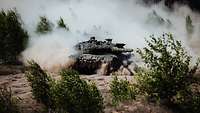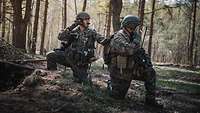
NATO
Wales, Warsaw and Madrid: landmark NATONorth Atlantic Treaty Organization summits
First paragraph of the articleThe NATONorth Atlantic Treaty Organization summits in Wales, Warsaw and Madrid
Over the past ten years, the Alliance has shown a decisive response to the challenging security situation in Europe. Operational readiness and defence planning were adapted in decisions taken at NATONorth Atlantic Treaty Organization summits. Germany has played a major role in implementing these decisions to protect the Alliance.
NATONorth Atlantic Treaty Organization’s ongoing adaptation process is largely characterised by the Russian war against Ukraine and by military and hybrid provocations and actions. With the illegal annexation of the Crimean peninsula in 2014 and the continued destabilisation of Eastern Ukraine, Russia initially called into question the rules-based European peace architecture and put a heavy strain on relations with NATONorth Atlantic Treaty Organization. The Alliance responded to this in the same year during its summit in Wales.
We, the heads of state and government of the member states of the North Atlantic Alliance, have met in Wales at a crucial time for Euro-Atlantic security. Russia’s aggressive action against Ukraine has fundamentally shaken our vision of an undivided, free and peaceful Europe.Wales Summit Declaration, 5 September 2014
The heads of state and government of NATONorth Atlantic Treaty Organization adopted the Readiness Action Plan in Wales. This includes reinforcing airspace surveillance – the so-called air policing – with permanently operational combat aircraft, employing AWACSAirborne Early Warning and Control System aircraft on NATONorth Atlantic Treaty Organization’s eastern flank, a stronger presence of naval forces in the Baltic Sea, the Black Sea and the Mediterranean, as well as more frequent international NATONorth Atlantic Treaty Organization exercises. The Bundeswehr has regularly participated in these activities since the Action Plan was adopted.
VJTFVery High Readiness Joint Task Force : NATONorth Atlantic Treaty Organization spearhead for rapid response
The establishment of the VJTFVery High Readiness Joint Task Force was also agreed at the summit in Newport, Wales. It is part of the NRFNATO Response Force, the NATONorth Atlantic Treaty Organization Response Force, and can be deployed particularly quickly. With this NATONorth Atlantic Treaty Organization spearhead, it is possible to quickly respond to developments in respect of the security situation. Its land component consists of a reinforced multinational combat brigade. In addition, the VJTFVery High Readiness Joint Task Force also includes air and naval forces as well as cyber and special forces. Germany already played a major role in the formation of the VJTFVery High Readiness Joint Task Force as a framework nation. After 2014 and 2019, the Bundeswehr in 2023 will also provide the lead element for the land components of the NATONorth Atlantic Treaty Organization spearhead, with approximately 17,000 troops.
In the Wales Summit Declaration, the Alliance stated that it continues to strive for cooperative and constructive relations with Russia, although this seemed impossible given the current conditions. Cooperation with the Russian military was discontinued. However, a military crisis contact mechanism does exist in principle, the purpose of which is to resolve military incidents and avoid uncontrolled escalation dynamics.
NATONorth Atlantic Treaty Organization’s two-percent target
At the Wales summit, the NATONorth Atlantic Treaty Organization member states also committed to providing their armed forces with the appropriate resources – in terms of both funding and materiel – in order to strengthen collective defence and resilience. Germany stands by the intention it expressed in Wales. The German defence budget has been growing steadily since then. Thanks to the special fund set up for the Bundeswehr in 2022, which amounts to up to 100 billion euros – in addition to the actual defence budget –, Germany will spend 2 percent of its GDP as an average over a multi-year period in order to contribute to NATONorth Atlantic Treaty Organization’s capability targets.
Warsaw summit: battlegroups for the eastern flank
Two years later – at the Warsaw summit in 2016 – NATONorth Atlantic Treaty Organization made further decisions to protect Alliance territory. The summit declaration states that ‘Russia’s aggressive actions, including provocative military activities in the periphery of NATONorth Atlantic Treaty Organization territory and its demonstrated willingness to attain political goals by the threat and use of force, are a source of instability’. Examples of these provocations are the repeated violations of NATONorth Atlantic Treaty Organization airspace by Russian aircraft. This causes NATONorth Atlantic Treaty Organization Air Policing fighter jets to be alerted to intercept the Russian aircraft.
In Warsaw, the decision was made to station a total of four multinational battlegroups in Eastern Europe. They are deployed in the three Baltic states of Estonia, Latvia and Lithuania as well as in Poland as an enhanced Forward Presence (eFP). Some 1,000 service personnel from different NATONorth Atlantic Treaty Organization nations form one battlegroup headed by a framework nation. From the very beginning, Germany has been in charge of the battlegroup in Lithuania, which reports to Lithuania’s Iron Wolf Brigade.
Madrid summit: more response forces
The first summit of the Alliance after Russia’s attack on Ukraine on 24 February 2022 took place in Madrid and saw far-reaching decisions. In addition to approving Sweden’s and Finland’s accession to the Alliance, NATONorth Atlantic Treaty Organization decided to make further adjustments to improve responsiveness and defence capability in view of the illegal invasion of Ukraine. In their summit declaration, the heads of state and government emphasised that ‘NATONorth Atlantic Treaty Organization will continue to protect our populations and defend every inch of Allied territory at all times’. The new NATONorth Atlantic Treaty Organization Strategic Concept adopted in Madrid states that ‘in light of its hostile policies’, Russia cannot be considered a partner. It declares Russia a threat to Europe’s security.
The Alliance will respond to this threat situation by increasing the number of NATONorth Atlantic Treaty Organization response forces to include around 300,000 service personnel. A new structure that involves assignment to particular regions will be introduced for the response forces. In Lithuania, the Bundeswehr has already shown how this could work: a forward command post was set up in Rukla to prepare exercises and the potential deployment of a combat brigade from Germany. This allows service personnel to be transferred quickly from Germany to Lithuania for exercises or in the event of a threat situation. Under certain conditions, a German brigade will be stationed permanently in Lithuania in the future.
Credible deterrence and defence
From Wales to Warsaw to Madrid: NATONorth Atlantic Treaty Organization has expanded its collective defence, enhanced its capabilities and strengthened its resilience. These military and political adjustments show that NATONorth Atlantic Treaty Organization is predictable in its adherence to international regulations and commitments since all of these decisions are in accordance with international law. Moreover, they demonstrate NATONorth Atlantic Treaty Organization’s resolve to protect Alliance territory with credible deterrence and defence.
The Bundeswehr’s contributions are an expression of Germany’s reliability when it comes to Alliance solidarity. ‘We stand resolutely by the mutual defence pledge under Article 5 of the North Atlantic Treaty,’ says the first ever German National Security Strategy.
| NATONorth Atlantic Treaty Organization summit meetings |
|---|
| At NATONorth Atlantic Treaty Organization summits, the heads of state and government of all member states gather, forming the North Atlantic Council – the highest political decision-making body of the Alliance, as defined by the Washington Treaty. These meetings are usually held every two years. As a rule, the delegations also include the respective foreign and defence ministers because both of these ministries are responsible for the security and defence policy of their countries. Representatives of allied partner countries that are not NATONorth Atlantic Treaty Organization members are also invited to summit meetings. |


Share content on